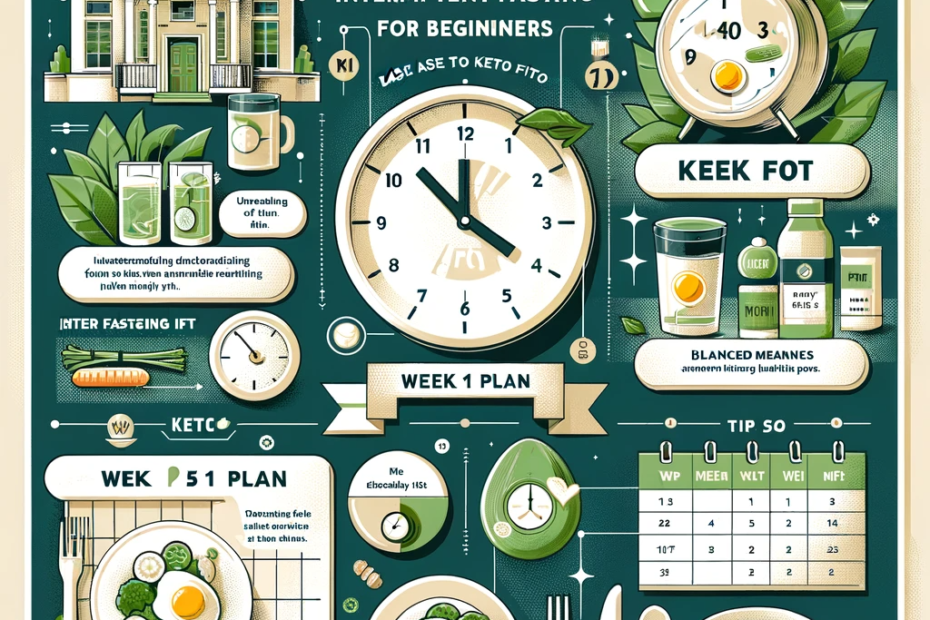Keto Intermittent Fasting (IF) Diet Plan for Beginners
Combining the ketogenic diet with intermittent fasting (IF) can be a powerful strategy for beginners seeking enhanced health benefits. This guide provides a comprehensive plan to help you seamlessly integrate these two approaches for optimal results.
Understanding Keto IF: The Synergy of Two Protocols
Keto Diet Basics:
- High-fat, moderate-protein, low-carbohydrate eating pattern.
- Aims to induce a state of ketosis, where fat is the primary energy source.
Intermittent Fasting (IF) Explained:
- Involves cycling between periods of eating and fasting.
- Common patterns include 16/8 (16 hours fasting, 8 hours eating) or 5:2 (five days of normal eating, two days of reduced calorie intake).
Combined Benefits:
- Enhanced fat loss, improved insulin sensitivity, and potential cognitive benefits.
- May lead to more significant health improvements than either approach alone.
Week 1: Introduction to Keto IF
Phase 1: Entering Ketosis
- Days 1-3: Gradually reduce carbohydrate intake to less than 20 grams per day. Increase your intake of healthy fats like avocados, nuts, and olive oil. Consume moderate amounts of protein.
- Hydration and Electrolytes: Drink plenty of water and incorporate electrolyte-rich foods or supplements to mitigate initial side effects like the keto flu.
Phase 2: Integrating Intermittent Fasting
- Days 4-7: Begin with a mild fasting approach, such as 12/12 (12 hours fasting, 12 hours eating window). Gradually increase fasting time as comfortably.
- Break Your Fast Gently: Start with a small, high-fat meal. Avoid breaking your fast with a large, heavy meal.
Sample Keto IF Meal Plan
Here’s a basic 7-day meal plan to guide you:
Day 1-3 (Keto Adaptation):
- Breakfast: Scrambled eggs with spinach cooked in butter.
- Lunch: Salad with mixed greens, grilled chicken, cheese, and avocado.
- Dinner: Baked salmon with steamed broccoli and a side of cauliflower rice.
Day 4-7 (Integrating IF, 12/12 Fasting):
- Breakfast (Break the Fast): A handful of nuts and a cheese slice.
- Lunch: Beef stir-fry with a variety of low-carb vegetables.
- Dinner: Grilled pork chops with asparagus and a butter drizzle.
Tips for Success
- Monitor Your Body’s Response: Pay attention to how your body reacts to the combined approach. Adjust the fasting duration and meal composition as needed.
- Stay Hydrated: Drink water throughout the day, especially during fasting periods.
- Avoid Overeating: During your eating window, focus on nutrient-dense foods and listen to your body’s hunger cues.
Overcoming Challenges
- Hunger Pangs: Initially, you might experience hunger during fasting periods. Herbal teas or black coffee can help curb hunger.
- Social Eating: Plan your fasting windows around your social schedule to maintain a balance.
- Keto IF in Daily Life: Integrate Keto IF into your lifestyle in a way that feels sustainable and flexible for you.
Final Thoughts
Combining keto with intermittent fasting can be an effective approach for beginners looking to maximise health benefits. As with any dietary change, it’s important to listen to your body, make adjustments as needed, and consult with a healthcare professional, especially if you have any underlying health conditions. Embrace this journey with patience and commitment, and you may find Keto IF to be a rewarding and sustainable lifestyle choice.
 Advancing Your Keto IF Practice: Beyond the Basics
Advancing Your Keto IF Practice: Beyond the Basics
As you become more comfortable with the Keto IF lifestyle, it’s time to delve deeper and optimise your routine for sustained success. Let’s explore advanced strategies and tips to enhance your Keto IF experience.
Refining Your Fasting Schedule
- Experiment with Longer Fasts: Gradually increase your fasting window to 16/8 or even 20/4 as you become more adapted. This can accelerate ketosis and fat loss.
- Flexible Fasting: Adapt your fasting schedule based on your daily routine and energy needs. Some days might suit longer fasts, while others may require shorter fasting periods.
Optimising Your Keto Meals
- Nutrient Density: Focus on incorporating a variety of nutrient-rich foods. Leafy greens, fatty fish, nuts, and seeds provide essential vitamins and minerals.
- Meal Timing: Align your meals to support your activities. For instance, a higher protein meal post-exercise can aid in recovery.
- Portion Control: Be mindful of portion sizes. Overeating, even in the eating window, can hinder your progress.
Advanced Keto IF Techniques
- Cyclical Keto Diet: Once adapted, some may benefit from incorporating higher carb days. This can be particularly beneficial for those with higher physical activity levels.
- Fat Fasting: Introducing days with very high fat and minimal protein and carbs can deepen ketosis and break plateaus.
Monitoring and Adjusting Your Plan

- Track Your Progress: Use tools like food diaries, ketone metres, and body composition scales to monitor your progress and make informed adjustments.
- Listen to Your Body: Adapt your diet and fasting schedule based on how you feel. Energy levels, hunger cues, and physical performance are key indicators.
Integrating Exercise with Keto IF
- Exercise Timing: Experiment with working out in a fasted state for enhanced fat burning, or after eating for improved performance.
- Variety in Workouts: Incorporate a mix of aerobic, strength, and flexibility exercises to support overall health and prevent boredom.
Overcoming Plateaus and Setbacks
- Reassess Your Macros: If weight loss stalls, recalibrate your fat, protein, and carb intake.
- Change Your Fasting Pattern: Sometimes, a shift in your fasting schedule can reignite progress.
- Stay Patient and Persistent: Plateaus are normal. Stay consistent with your efforts.
Long-Term Sustainability
- Lifestyle Integration: Keto IF should fit into your life seamlessly. Make adjustments to ensure it’s a sustainable, long-term practice.
- Social and Emotional Well-Being: Maintain a healthy balance between dietary discipline and enjoying social occasions.
- Continuous Learning: Stay informed about the latest research and trends in keto and intermittent fasting.
Concluding Your Advanced Keto IF Journey
The combination of keto and intermittent fasting is a powerful tool for health and wellness. As you advance in your journey, remember that personalization and adaptability are key. Continue to listen to your body, adjust your approach as needed, and embrace the journey towards optimal health. With dedication and mindfulness, Keto IF can be a rewarding and sustainable pathway to achieving your health goals.
Mastery and Mindfulness in Your Keto IF Lifestyle
Advancing further in your Keto IF journey, the focus shifts towards mastering the intricacies of this lifestyle and maintaining mindfulness in your daily practices. Here, we’ll explore strategies for long-term mastery and the importance of a holistic approach.
Achieving Mastery in Keto IF
- Personalised Nutrition: Tailor your keto diet to your unique nutritional needs. This might involve adjusting your macro ratios or incorporating specific supplements based on your body’s responses.
- Advanced Fasting Techniques: Explore more advanced fasting methods like 24-hour fasts or OMAD (One Meal A Day), if it aligns with your health goals and lifestyle.
- Holistic Health Monitoring: Beyond weight and ketosis, monitor other health markers such as blood pressure, cholesterol levels, and blood sugar to ensure overall well-being.
Mindfulness and Intuitive Eating
- Mindful Eating Practices: Cultivate a practice of eating mindfully, savouring each bite, and being fully present during meals. This can enhance digestion and satisfaction from meals.
- Intuitive Eating: Learn to listen to your body’s hunger and fullness signals. Adjust your eating and fasting windows according to your body’s natural cues/

Balancing Keto IF with Life
- Flexibility is Key: Allow for flexibility in your diet and fasting schedule to accommodate special occasions, travel, or changes in routine.
- Sustainable Habits: Focus on building habits that are sustainable in the long term. Extreme restrictions or rigid rules can be counterproductive.
Continuous Education and Adaptation
- Stay Informed: Keep abreast of the latest research and developments in the fields of ketogenic diets and intermittent fasting.
- Adapt as You Age: Your body’s needs change over time. Be prepared to modify your approach to Keto IF as you age, focusing on nutrients that support longevity and vitality.
Expanding Your Culinary Skills

- Experiment with Keto Recipes: Continuously expand your repertoire of keto-friendly recipes. Experimenting in the kitchen can keep your diet interesting and enjoyable.
- Seasonal and Local Foods: Incorporate seasonal and local produce to add variety and freshness to your meals.
Building a Supportive Community
- Share Your Knowledge: As you gain expertise, share your knowledge and experiences with others who are new to Keto IF. Mentorship can be incredibly rewarding.
- Engage in Support Groups: Participate in or even lead support groups, online forums, or local meetups. This fosters a sense of community and shared learning.
Embracing a Holistic Wellness Philosophy
- Beyond Diet and Exercise: Recognize that wellness encompasses mental, emotional, and spiritual health. Engage in practices that nourish all aspects of your being.
- Lifelong Wellness Journey: View Keto IF not just as a diet or a temporary health fix, but as a component of a lifelong journey towards wellness.
Final Reflections on Your Keto IF Journey
As you master the Keto IF lifestyle, remember that the journey is as much about personal growth and wellbeing as it is about physical health. By staying mindful, adaptable, and committed to continuous learning, you can make Keto IF a rewarding and enriching part of your life. Embrace this journey with an open heart and mind, and enjoy the profound benefits it can bring to your overall quality of life.







